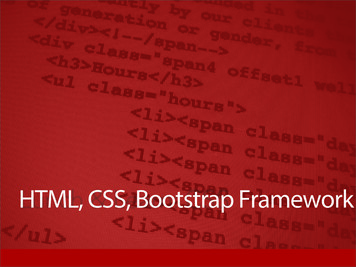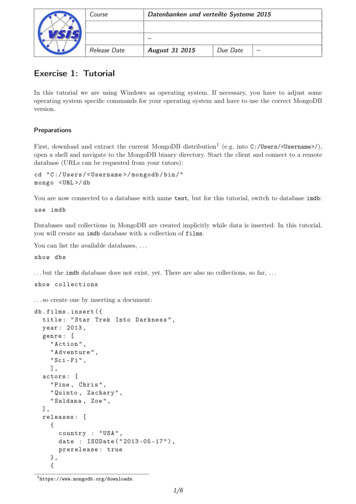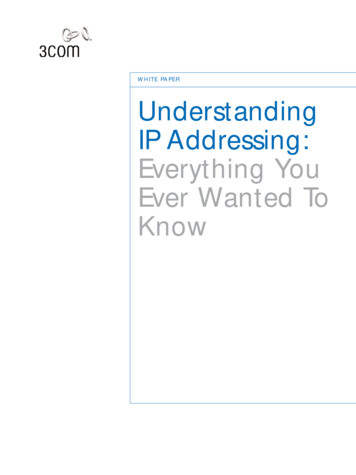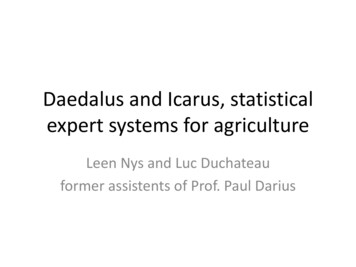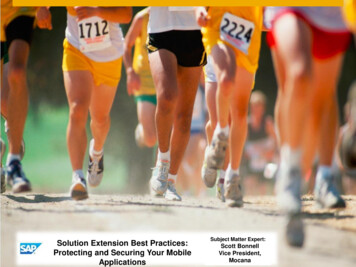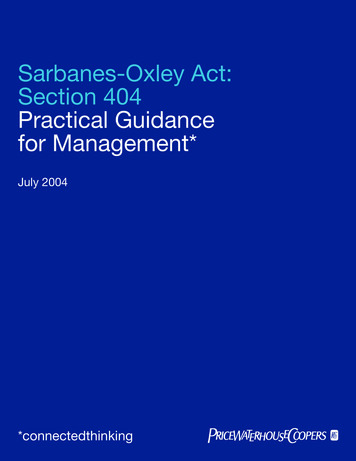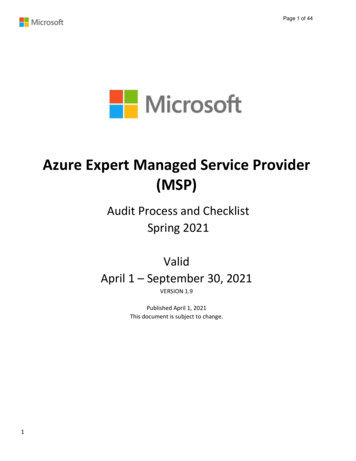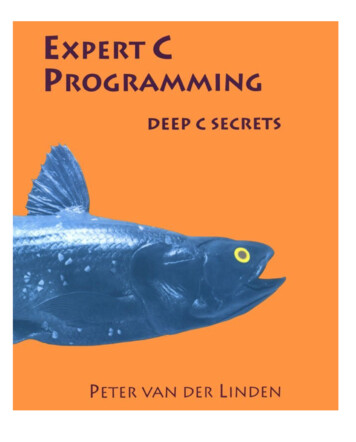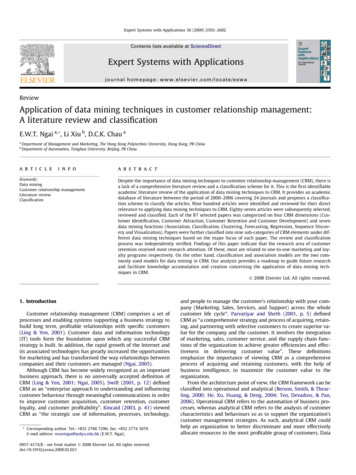
Transcription
Expert Systems with Applications 36 (2009) 2592–2602Contents lists available at ScienceDirectExpert Systems with Applicationsjournal homepage: www.elsevier.com/locate/eswaReviewApplication of data mining techniques in customer relationship management:A literature review and classificationE.W.T. Ngai a,*, Li Xiu b, D.C.K. Chau aabDepartment of Management and Marketing, The Hong Kong Polytechnic University, Hong Kong, PR ChinaDepartment of Automation, Tsinghua University, Beijing, PR Chinaa r t i c l ei n f oKeywords:Data miningCustomer relationship managementLiterature reviewClassificationa b s t r a c tDespite the importance of data mining techniques to customer relationship management (CRM), there isa lack of a comprehensive literature review and a classification scheme for it. This is the first identifiableacademic literature review of the application of data mining techniques to CRM. It provides an academicdatabase of literature between the period of 2000–2006 covering 24 journals and proposes a classification scheme to classify the articles. Nine hundred articles were identified and reviewed for their directrelevance to applying data mining techniques to CRM. Eighty-seven articles were subsequently selected,reviewed and classified. Each of the 87 selected papers was categorized on four CRM dimensions (Customer Identification, Customer Attraction, Customer Retention and Customer Development) and sevendata mining functions (Association, Classification, Clustering, Forecasting, Regression, Sequence Discovery and Visualization). Papers were further classified into nine sub-categories of CRM elements under different data mining techniques based on the major focus of each paper. The review and classificationprocess was independently verified. Findings of this paper indicate that the research area of customerretention received most research attention. Of these, most are related to one-to-one marketing and loyalty programs respectively. On the other hand, classification and association models are the two commonly used models for data mining in CRM. Our analysis provides a roadmap to guide future researchand facilitate knowledge accumulation and creation concerning the application of data mining techniques in CRM.Ó 2008 Elsevier Ltd. All rights reserved.1. IntroductionCustomer relationship management (CRM) comprises a set ofprocesses and enabling systems supporting a business strategy tobuild long term, profitable relationships with specific customers(Ling & Yen, 2001). Customer data and information technology(IT) tools form the foundation upon which any successful CRMstrategy is built. In addition, the rapid growth of the Internet andits associated technologies has greatly increased the opportunitiesfor marketing and has transformed the way relationships betweencompanies and their customers are managed (Ngai, 2005).Although CRM has become widely recognized as an importantbusiness approach, there is no universally accepted definition ofCRM (Ling & Yen, 2001; Ngai, 2005). Swift (2001, p. 12) definedCRM as an ‘‘enterprise approach to understanding and influencingcustomer behaviour through meaningful communications in orderto improve customer acquisition, customer retention, customerloyalty, and customer profitability”. Kincaid (2003, p. 41) viewedCRM as ‘‘the strategic use of information, processes, technology,* Corresponding author. Tel.: 852 2766 7296; fax: 852 2774 3679.E-mail address: mswtngai@polyu.edu.hk (E.W.T. Ngai).0957-4174/ - see front matter Ó 2008 Elsevier Ltd. All rights reserved.doi:10.1016/j.eswa.2008.02.021and people to manage the customer’s relationship with your company (Marketing, Sales, Services, and Support) across the wholecustomer life cycle”. Parvatiyar and Sheth (2001, p. 5) definedCRM as ‘‘a comprehensive strategy and process of acquiring, retaining, and partnering with selective customers to create superior value for the company and the customer. It involves the integrationof marketing, sales, customer service, and the supply chain functions of the organization to achieve greater efficiencies and effectiveness in delivering customer value”. These definitionsemphasize the importance of viewing CRM as a comprehensiveprocess of acquiring and retaining customers, with the help ofbusiness intelligence, to maximize the customer value to theorganization.From the architecture point of view, the CRM framework can beclassified into operational and analytical (Berson, Smith, & Thearling, 2000; He, Xu, Huang, & Deng, 2004; Teo, Devadoss, & Pan,2006). Operational CRM refers to the automation of business processes, whereas analytical CRM refers to the analysis of customercharacteristics and behaviours so as to support the organization’scustomer management strategies. As such, analytical CRM couldhelp an organization to better discriminate and more effectivelyallocate resources to the most profitable group of customers. Data
E.W.T. Ngai et al. / Expert Systems with Applications 36 (2009) 2592–2602mining tools are a popular means of analyzing customer data within the analytical CRM framework. Many organizations have collected and stored a wealth of data about their current customers,potential customers, suppliers and business partners. However,the inability to discover valuable information hidden in the dataprevents the organizations from transforming these data into valuable and useful knowledge (Berson et al., 2000). Data mining toolscould help these organizations to discover the hidden knowledgein the enormous amount of data.Turban, Aronson, Liang, and Sharda (2007, p.305) defines datamining as ‘‘the process that uses statistical, mathematical, artificialintelligence and machine-learning techniques to extract and identify useful information and subsequently gain knowledge fromlarge databases”. Berson et al. (2000), Lejeune (2001), Ahmed(2004) and Berry and Linoff (2004) also provide a similar definitionregarding data mining as being the process of extracting or detecting hidden patterns or information from large databases. Withcomprehensive customer data, data mining technology can providebusiness intelligence to generate new opportunities (Bortiz & Kennedy, 1995; Fletcher & Goss, 1993; Langley & Simon, 1995; Lau,Wong, Hui, & Pun, 2003; Salchenberger, Cinar, & Lash, 1992; Su,Hsu, & Tsai, 2002; Tam & Kiang, 1992; Zhang, Hu, Patuwo, & Indro,1999).The application of data mining tools in CRM is an emergingtrend in the global economy. Analyzing and understanding customer behaviours and characteristics is the foundation of thedevelopment of a competitive CRM strategy, so as to acquire andretain potential customers and maximize customer value. Appropriate data mining tools, which are good at extracting and identifying useful information and knowledge from enormouscustomer databases, are one of the best supporting tools for making different CRM decisions (Berson et al., 2000). As such, the application of data mining techniques in CRM is worth pursuing in acustomer-centric economy.This paper presents a comprehensive review of literaturerelated to application of data mining techniques in CRM published in academic journals between 2000 and 2006. A classification of framework is also presented. The paper is organized asfollows: first, the research methodology used in the study isdescribed; second, the method for classifying data mining articlesin CRM is presented; third, articles about data mining in CRM areanalysed and the results of the classification are reported; andfinally, the conclusions, limitations and implications of the studyare discussed.2. Research methodologyAs the nature of research in CRM and data mining are difficult toconfine to specific disciplines, the relevant materials are scatteredacross various journals. Business intelligence and knowledge discovery are the most common academic discipline for data miningresearch in CRM. Consequently, the following online journal databases were searched to provide a comprehensive bibliographyof the academic literature on CRM and Data Mining: ABI/INFORM Database;Academic Search Premier;Business Source Premier;Emerald Fulltext;Ingenta Journals;Science Direct; andIEEE Transaction.The literature search was based on the descriptor, ‘‘customerrelationship management” and ‘‘data mining”, which originally2593produced approximately 900 articles. The full text of each articlewas reviewed to eliminate those that were not actually related toapplication of data mining techniques in CRM. The selection criteria were as follows: Only those articles that had been published in business intelligence, knowledge discovery or customer management relatedjournals were selected, as these were the most appropriate outlets for data mining in CRM research and the focus of thisreview. Only those articles which clearly described how the mentioneddata mining technique(s) could be applied and assisted in CRMstrategies were selected. Conference papers, masters and doctoral dissertations, textbooks and unpublished working papers were excluded, asacademics and practitioners alike most often use journals toacquire information and disseminate new findings. Thus, journals represent the highest level of research (Nord & Nord, 1995).Each article was carefully reviewed and separately classifiedaccording to the four categories of CRM dimensions and seven categories of data mining models, as shown in Fig. 1. Although thissearch was not exhaustive, it serves as a comprehensive base foran understanding of data mining research in CRM.3. Classification methodAccording to Swift (2001, p. 12), Parvatiyar and Sheth (2001, p.5) and Kracklauer, Mills, and Seifert (2004, p. 4), CRM consists offour ent.These four dimensions can be seen as a closed cycle of a customer management system (Au & Chan, 2003; Kracklauer et al.,2004; Ling & Yen, 2001). They share the common goal of creatinga deeper understanding of customers to maximize customer valueto the organization in the long term. Data mining techniques,therefore, can help to accomplish such a goal by extracting ordetecting hidden customer characteristics and behaviours fromlarge databases. The generative aspect of data mining consists ofthe building of a model from data (Carrier & Povel, 2003). Each datamining technique can perform one or more of the following typesof data e discovery;Visualization.The above seven models cover the generally mentioneddata mining models in various articles (Ahmed, 2004; Carrier & Povel, 2003; Mitra, Pal, & Mitra, 2002; Shaw, Subramaniam, Tan, &Welge, 2001; Turban et al., 2007). There are numerous machinelearning techniques available for each type of data mining model.Choices of data mining techniques should be based on the datacharacteristics and business requirements (Carrier & Povel, 2003).Here are some examples of some widely used data miningalgorithms:
2594E.W.T. Ngai et al. / Expert Systems with Applications 36 (2009) 2592–2602Fig. 1. Classification framework for data mining techniques in CRM.(1)(2)(3)(4)(5)(6)Association rule;Decision tree;Genetic algorithm;Neural networks;K-Nearest neighbour;Linear/logistic regression.A graphical classification framework on data mining techniques in CRM is proposed and shown in Fig. 1; it is based ona review of the literature on data mining techniques in CRM. Critically reviewing the literature on data mining in CRM helped toidentify the major CRM dimensions and data mining techniquesfor the application of data mining techniques in CRM. This framework is also based on the research conducted by Swift (2001),Parvatiyar and Sheth (2001) and Kracklauer et al. (2004). Theydescribed CRM dimensions as: Customer Identification, CustomerAttraction, Customer Retention and Customer Development. Inaddition, Ahmed, 2004; Carrier and Povel, 2003; Mitra et al.,2002; Shaw et al., 2001 described the types of data mining modelas Association, Classification, Clustering, Forecasting, Regression,Sequence Discovery and Visualization. We provide a briefdescription of these four dimensions and some references for further details, and each of them is discussed in the followingsections.3.1. Classification framework – CRM dimensionsIn this study, CRM is defined as helping organizations to betterdiscriminate and more effectively allocate resources to the mostprofitable group of customers through the cycle of customer identification, customer attraction, customer retention and customerdevelopment. Detailed knowledge must be built up systematicallyso as to obtain a deeper understanding of each customer’s behaviours, characteristics and needs. The four dimensions of the CRMcycle are essential efforts to gain customer insight (Ling & Yen,2001).(i) Customer identification: CRM begins with customer identification, which is referred to as customer acquisition in somearticles. This phase involves targeting the population whoare most likely to become customers or most profitable tothe company. Moreover, it involves analyzing customerswho are being lost to the competition and how they canbe won back (Kracklauer et al., 2004). Elements for customeridentification include target customer analysis and customersegmentation. Target customer analysis involves seeking theprofitable segments of customers through analysis of customers’ underlying characteristics, whereas customer segmentation involves the subdivision of an entire customerbase into smaller customer groups or segments, consistingof customers who are relatively similar within each specificsegment (Woo, Bae, & Park, 2005).(ii) Customer attraction: This is the phase following customeridentification. After identifying the segments of potentialcustomers, organizations can direct effort and resources intoattracting the target customer segments. An element of customer attraction is direct marketing. Direct marketing is apromotion process
Operational CRM refers to the automation of business pro-cesses, whereas analytical CRM refers to the analysis of customer characteristics and behaviours so as to support the organization’s customer management strategies. As such, analytical CRM could help an organization to better discriminate and more effectively allocate resources to the most profitable group of customers. Data 0957-4174 .


